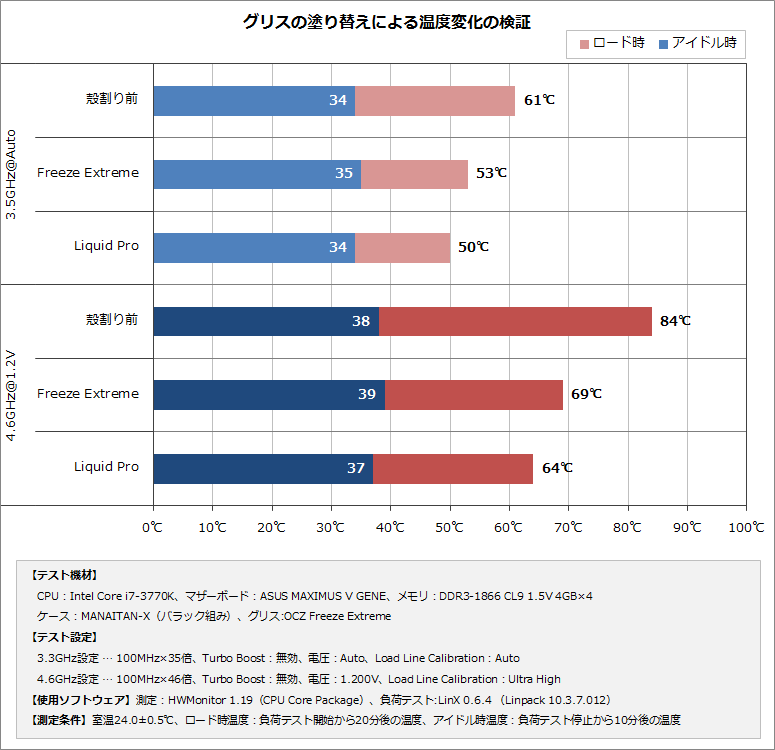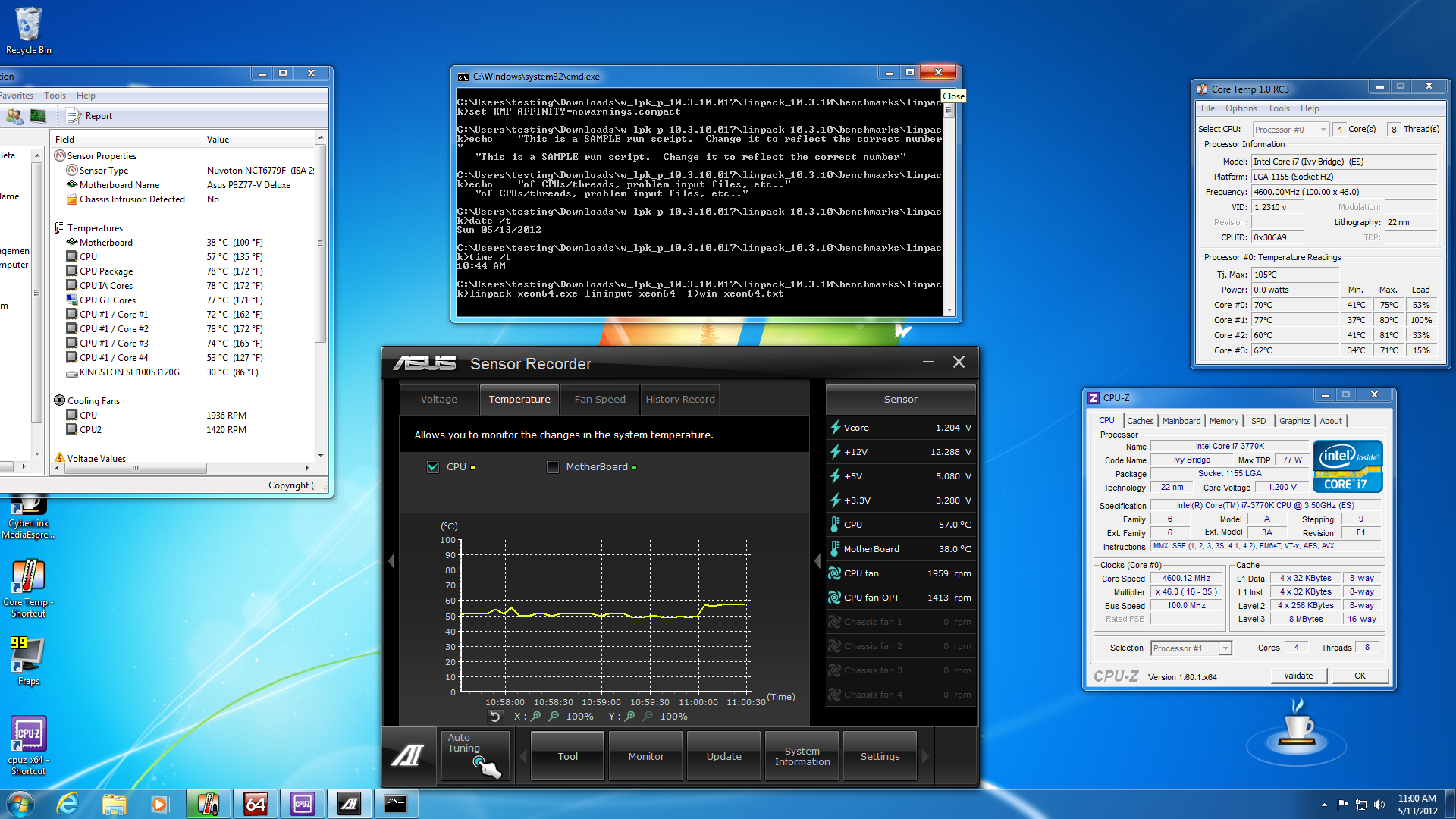Then there was an article that came out claiming that it was due to the use of Thermal Interface Material instead of Fluxless solder (that is actually an improper name as the material used still has flux, it is just minimal and used for thermal shifting). Right after this we saw a couple of tests done that appear to counter this claim. These tests involved removing the IHS and scraping off the TIM. They replaced it with different thermal compounds and ran the same CPU under the same loads (both were overclocked to 4.8GHz) the difference between the CPU with the TIM and IHS were nearly identical to the temps recorded with the better thermal compound and with direct die contact.
Now another test has popped up, this one caught our eye because it is claiming the opposite of the other testing we have seen. One of the things that stood out though was the load temperature during a 4.6GHz overclock of a 3770k with the IHS and original TIM in place. According to the tests the 3770K hit a staggering 84c under load! We have not even seen this when running at 4.8GHz @ 1.36-1.38V. Yet hear they were saying that Ivy Bridge hit 84c at 4.6GHz with only 1.2V. 
We decided to do some testing of our own. We used a Cooler Master Hyper 212 Evo with an additional fan for our air cooling. The first thing we noted in our testing was that we could not really get a full stable 4.6GHz OC at 1.2V on our Asus P8Z77-V Deluxe (stability did not come until 1.25V). Still we persisted and kept that voltage. Under the load of Cinebench, LightWave 3D and HyperPi we hit a MAX single core temp of 72c and an average of 65c for the whole CPU which is considerably less than the 84c claimed in the recent article from Impress PC Watch translated page.
So what is happening here? Is the article wrong? Are they fudging the numbers? Or is this an issue where the testing was not completely apples to apples? The information on testing is not all present. We know they ran Linpack 10.3.7.012, but not for how long (at least it did not show up in any of the translations) we are also not sure if they tested the same CPU beforehand with the IHS in place and then pulled the lid or if they did this after and put on a similar looking paste (we doubt this happened, but as it is not really documented it is possible). We know they replaced the IHS after applying their new materials (most of the other results we saw did direct die testing and show almost no change), but again there is not much to go on, all we know is that everyone is assuming the TIM is a silicon based material.
I have some Diamond thermal paste here (courtesy of Acoustic PC) and it looks a lot like some of the TIM I have seen on GPUs and even on cheap heatsinks, but I can tell you it performs very well even if it looks cheap and nasty. Again we are guessing here and will have to wait to see how the tests were performed and what conditions the “stock” CPU was run under, but something is not quite right.
Even running Linpack on the same CPU at 1.28V for stability we did not hit 84c on any of the CPU cores after 15 minutes of testing. Again our max single core temp was only 81c with the average total CPU temp under 60c. You can see in the screen shot below AIDA64, CoreTemp and AISuite II’s sensor recorder. This was taken at the end of 15 minutes of Linkpack 10.3.017. During the testing we saw very limited spikes in temp (that is where the 80 and 81c readings came from) but the average temps were much, much lower (around 72-74c). 
Sure you can make a case saying that 84c is possible considering spikes (our biggest spike was 81c on Core 2 and we were running a higher voltage), but that is not a consistent temp and is not representative of what we are seeing with our sample here under continued load testing. We do not have the luxury of skinning our 3770k (we only have the one) so we have not done any testing with the IHS removed yet. We are working to get one so we can test though and see what the differences are for ourselves. Until then we do advise everyone to take both sets of reports with a grain of salt and read their results VERY carefully. You might find some inconstancies in them. We still stand behind our stance that the TIM used by Intel for Ivy Bridge is not the cause of the thermal issues. We feel this is the growing pains of moving to a new process (22nm) along with a new design (3D transistors) and a few other funs items.
As always we will carefully follow the news about this and we hope to be able to provide you with some more conclusive information in the near future.
Discuss this in our Forum

 Ivy Bridge has not been the best launch for Intel in terms of enthusiasts. Since the release of the Core microarchitecture many overclocker’s, gamers and plain PC nuts have loved the performance and overclockability of Intel’s CPUs. However, with Ivy Bridge despite the performance improvements there are some that are not happy. We have seen countless articles talking about the difficulty of overclocking Ivy Bridge even in our labs our best non-stable OC has been to 5GHz (CPUz only) we have not hit anything above 4.8GHz with any type of stability.
Ivy Bridge has not been the best launch for Intel in terms of enthusiasts. Since the release of the Core microarchitecture many overclocker’s, gamers and plain PC nuts have loved the performance and overclockability of Intel’s CPUs. However, with Ivy Bridge despite the performance improvements there are some that are not happy. We have seen countless articles talking about the difficulty of overclocking Ivy Bridge even in our labs our best non-stable OC has been to 5GHz (CPUz only) we have not hit anything above 4.8GHz with any type of stability.

